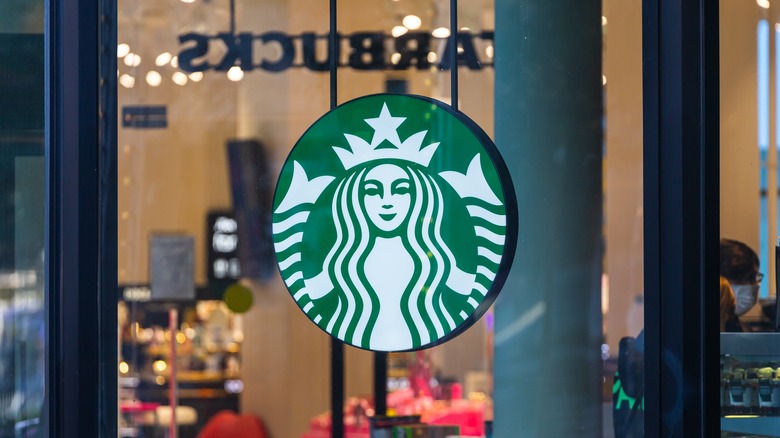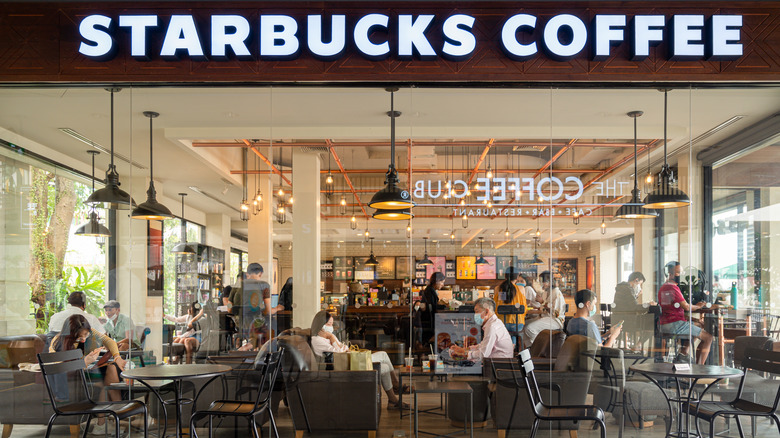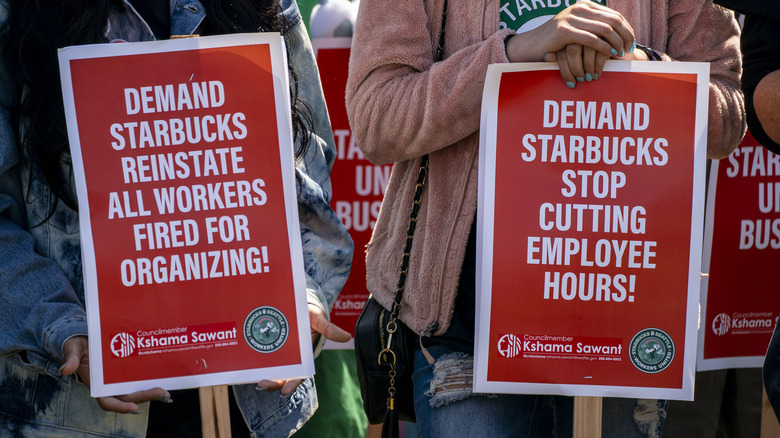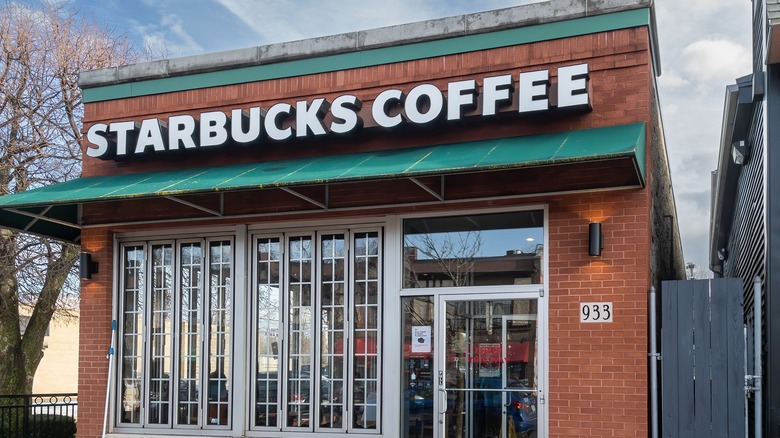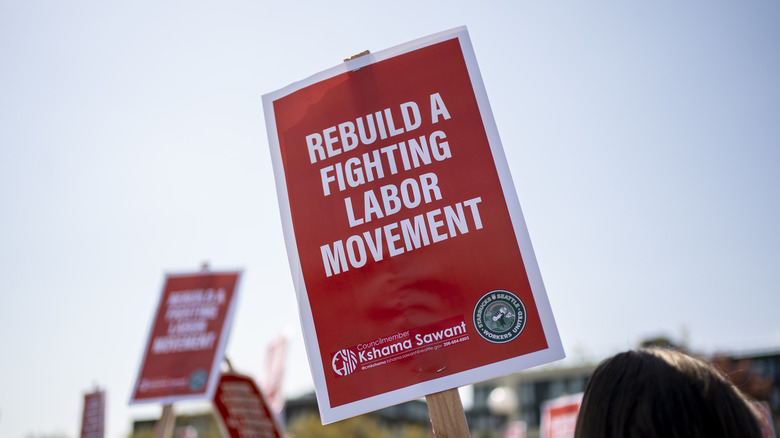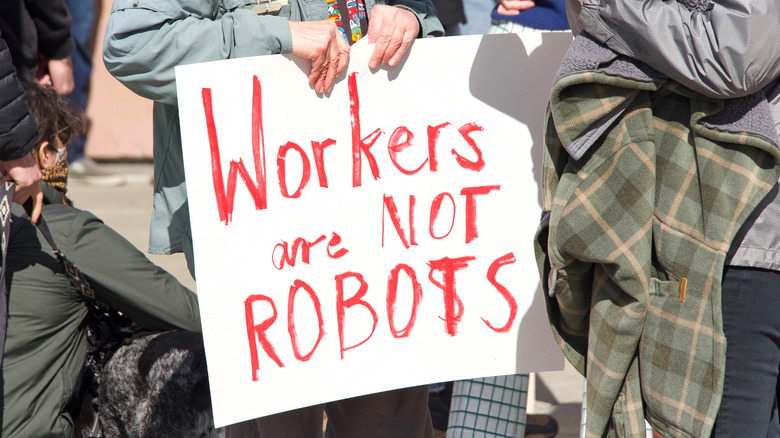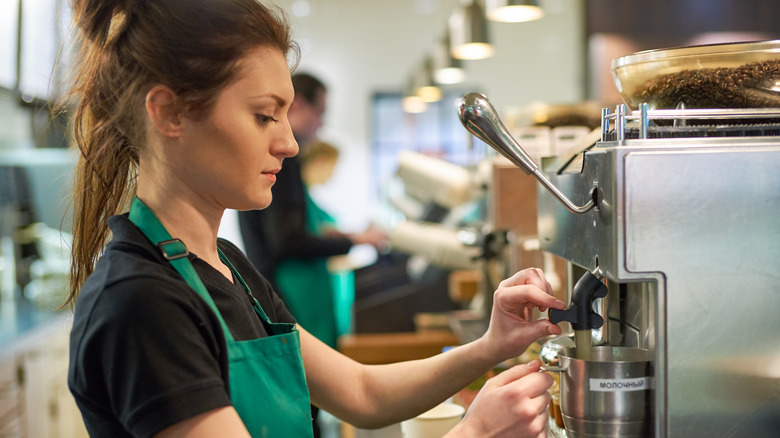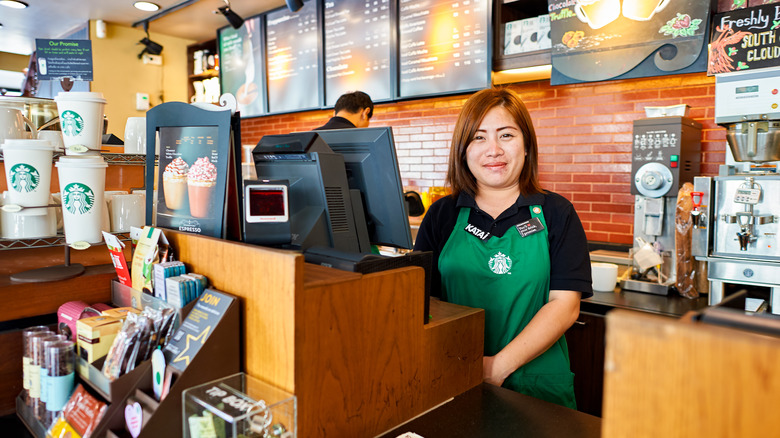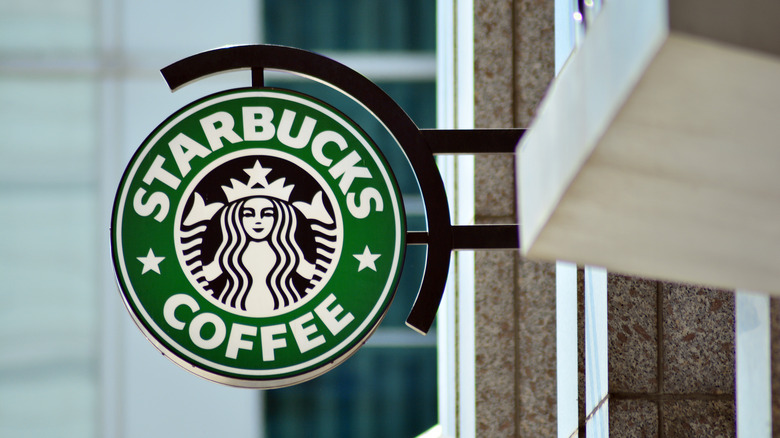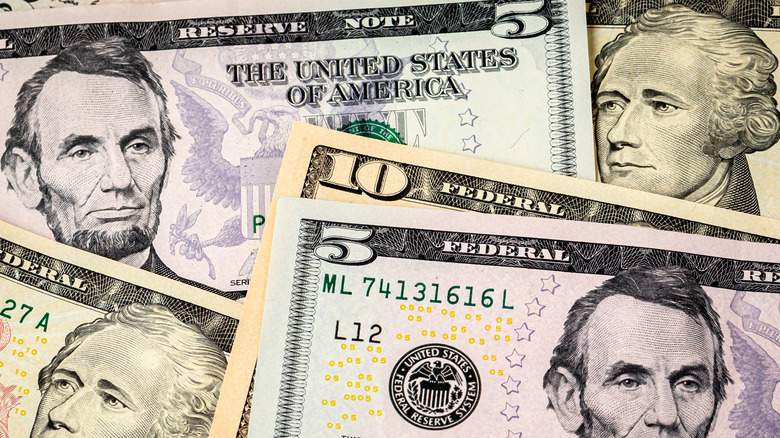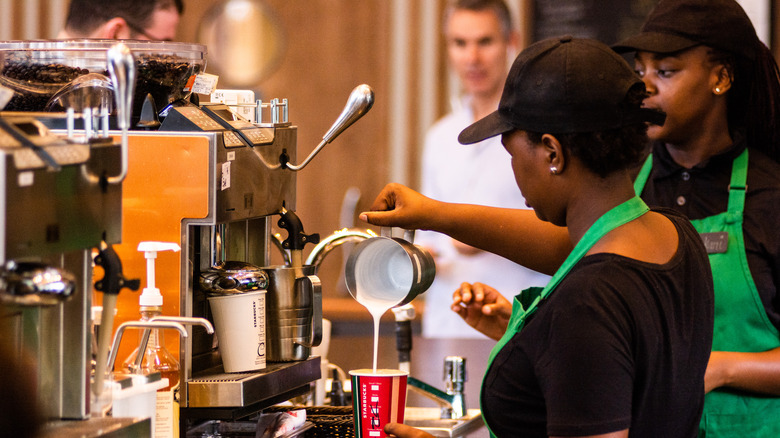The Push To Unionize Starbucks, Explained
Unions aren't anything new — according to the National Labor Relations Board, the National Labor Relations Act was signed into law in the U.S. in 1935, legalizing unions and allowing workers to join forces to advocate for themselves in the workplace. But while some industries, like utilities, transportation, and the public sector, have largely enjoyed widespread union benefits for years, other industries, like food service, generally aren't unionized.
But that's changing. Amazon workers were able to successfully form a union, says Business Insider, which has spurred employees at other large corporations to push for their own unions. Perhaps one of the most well-publicized union efforts involves Starbucks, the massive multi-national coffee chain. Although Starbucks employees generally enjoy better benefits than other food service workers, many are trying to gain more leverage in the workplace by pushing for a union — but Starbucks corporate is pushing back, (via The Boston Globe). The company that has wildly popular drinks has waged an aggressive anti-union campaign in the last several months that is raising eyebrows. We decided to take a closer look at the push to unionize Starbucks and what it means for food service workers moving forward.
Many believe the pandemic pushed the union fight
According to The Guardian, Starbucks has been around since 1971, which raises the question: Why are workers trying to organize a union now? Of course, the push to unionize Starbucks results from a myriad of factors, but many, like CNBC, have pointed to the pandemic as a major cause for the move. While some workers were able to stay at home and avoid contact with others, therefore minimizing their risk of falling ill with COVID-19, food service workers were faced with a difficult decision: Either keep their jobs and risk illness or lose their jobs — and their source of income — in the process.
One Starbucks worker told Brookings, "We were tired and we were scared. And we were feeling incredibly undervalued and unappreciated. We are being called 'essential workers' and we are putting our health and safety at risk to work through this pandemic. And we're hearing our CEO on CNN and other financial shows announce these record-breaking profits... And I know that this money is coming from my labor and my coworkers' labor. I've got co-workers who are crying in the back room because they don't know if they're going to be able to pay their rent and put groceries in their fridge that week."
A union may give employees more workplace leverage
So, what will a union do for Starbucks workers, anyway? A union doesn't guarantee a specific compensation package or benefits, but it does give workers leverage to set more favorable terms for their employment. The SB Workers United website states, "A union is an organization of workers who collectively use their strength to have a voice in their workplace. Having a union means having democracy at work." Without a union, company leadership calls all the shots. Even if those terms are favorable to the vast majority of employees, the employees don't get any say in making those decisions.
The union can provide legal protections for workers to ensure that they can negotiate contracts and expectations at work. Essentially, it gives them a bargaining chip. And considering that many food service employees were faced with difficult decisions during the pandemic, it makes sense that they would want more say in their workplace culture.
The Starbucks union is decidedly not anti-Starbucks
This is not to say that a Starbucks union would actively fight against the company's interests. SB Workers United claims that it is "pro-Starbucks and pro-union," considering that many of the employees involved in the unionization process have worked for Starbucks for long periods of time. In fact, the union claims that it wants to ensure that careers at Starbucks are sustainable and that employees are incentivized to stick around for the long haul.
While a union could present company leadership with new challenges, Forbes says that a union isn't necessarily a bad thing for the company. While some economists predict negative outcomes for companies that allow their workers to unionize, Forbes quotes Cheryl Carleton, an associate professor of economics at Villanova University, who says, "There's no proof this is true." Many companies and industries that have unionized in the past continue to thrive despite the more democratic decision-making processes.
The first Starbucks to unionize was in Buffalo, N.Y.
The most recent push to unionize Starbucks began in Buffalo, New York, according to the Associated Press. Workers at a Starbucks store on Elmwood Avenue decided to unionize in a 19-to-8 vote. This historic vote sent shockwaves throughout the labor movement. Just like the beginnings of the attempt to unionize at Amazon, the move was seen as a monumental shift. Unions were somewhat common decades ago, and, until these recent rumblings, labor rights were largely viewed as being in a state of decline. This vote worked to shift the conversation.
This move only directly affects the workers who are employed at this specific location, but it set wider unionization efforts into motion. Once Starbucks workers at other locations witnessed the union's success, they knew that it was possible to make the same move at their respective locations as well, says NPR — which explains the company's next moves.
Starbucks then launched an anti-union campaign
Once Starbucks workers started organizing, the company moved quickly with its anti-union campaign. Starbucks workers say the company has used a variety of tactics to ensure that union efforts never come to fruition. Among these tactics are one-on-one meetings, according to The Guardian, in which management holds a meeting with a single employee to speak to them about the union effort and attempted to convince them to vote against the union. Will Westlake, a Starbucks employee in Hamburg, New York, was reportedly invited to a meeting at a nearby hotel where six members of management separated him from the rest of his coworkers, discussed Starbucks benefits, and told him it was in his best interest to vote against the union.
Other tactics have reportedly involved "listening sessions" in which management speaks about the pitfalls of unionization and store shutdowns and closures. While management claims that these shutdowns have had nothing to do with shutting down unions, workers seem to think otherwise.
These tactics, among others, are known as "union busting," and they're essentially an attempt to prevent workers from forming a union. Union busting is technically illegal, according to Labor Lab, but these techniques are quite common. Starbucks has even launched a website to encourage workers to vote against unionization. But Slate claims that these tactics may actually end up working against the company in the long run.
Starbucks has a history with union-busting
While Starbucks' latest efforts to put a stop to unionization have happened in recent months, the company actually has a long-standing anti-union history. According to More Perfect Union, the recent push for unionization has forced Starbucks CEO Kevin Johnson to retire. Now, the company's former CEO, Howard Shultz, is coming back to take on the position again. But Shultz has had a history of being anti-union since the 1980s when he merged two coffee companies to create the coffee giant that Starbucks is today.
One of those companies had already unionized (and therefore enjoyed a variety of benefits), but Shultz reportedly made a concerted effort to break the union up. In his memoir published in 1999, he wrote, "I was convinced that under my leadership, employees would come to realize that I would listen to their concerns. If they had faith in me and my motives, they wouldn't need a union."
Another short-lived union campaign caught fire in the 1990s but was quickly squashed, and the same thing happened again in 2004. It comes as no surprise, then, to those who are familiar with the company, that Starbucks is again trying to end unionization efforts this time around.
Starbucks union organizers claimed they felt spied on
Not only has Starbucks allegedly employed union-busting tactics on a large scale, but individual employees have also said they've felt immense pressure to end union-organizing tactics. Per Slate, several baristas in Buffalo, New York, have said that they felt "spied on" by higher-ups in the company. In fact, Starbucks' president of retail for North America was even seen working directly with baristas — ostensibly to ensure that they weren't organizing on the job.
One district manager for the company was sent from Arizona to Buffalo to keep tabs on workers and was even captured on tape admitting that they were sent to the store as a "last-ditch effort to try and stop" a union from forming. This is just one more union-busting tactic that makes it more difficult for workers to organize and advocate for themselves. While these tactics may be immediately successful, there is a chance that employees could become fed up with the constant surveillance, which could prompt an even more aggressive pro-union response, says Slate.
Former workers claim they were fired due to unionization efforts
What's worse than being spied on by higher-ups at work? Getting fired because you attempted to unionize. It turns out that some recently fired Starbucks workers believe that they had been let go specifically due to their attempts to unionize, according to Eater. In early 2022, seven Starbucks workers at a Memphis, Tennessee, store were fired from their jobs in what they believe to be retaliation against attempting to form a union. Although the company did not say that the employees were being fired because of their attempts to unionize (which would be illegal), the workers seem to think it's no coincidence that everyone who was let go was actively working on unionization.
One of the employees, Kylie Throckmorton, told Eater about how she found out she had lost her job. She said, "[Management] started an investigation of people on our union committee and a few other baristas. On Monday, my proxy manager gave me a call and told me to come in for a one-on-one meeting. The store had been closed for a week due to the bad winter storm, and she said she wanted to do a check-in with the power and everything. When I got there, two people were there that I wasn't expecting, and they told me I'd been terminated."
Over 100 locations are attempting to unionize
While the current effort for unionization at Starbucks began with a small number of employees, the movement is now steadily growing. At the time of writing, more than 250 Starbucks locations are now attempting to unionize, according to NPR. And it doesn't look like it's slowing down anytime soon. Just like the formation of a union at Amazon garnered a massive amount of press, the same is true for the Starbucks union movement. As the union gains more traction, it's likely that even more Starbucks locations will push for unionization as well.
As it turns out, many of these stores' pushes for unionization have been successful. The Denver Post claimed in May 2022 that five stores in the state have voted to unionize. These five stores are just a fraction of the over 80 stores that have voted to unionize so far. For all of those rooting for the union's success, this momentum is a great sign.
The union wants a higher minimum wage for workers
So, what exactly is the union pushing for? Eater says that the union has not formally made any demands, but one worker told the outlet that he hopes the union will be able to negotiate a higher minimum wage for baristas. CNBC reported that Starbucks had planned to raise its minimum wage to $15 an hour by summer 2022, but some union organizers want to push for $25 an hour. As inflation continues to price gouge Americans, an extra $10 an hour would likely make a huge difference in many baristas' lives.
However, that's not all the union would be able to push for. It could also raise issues related to understaffing and other working conditions, according to the SB Workers United website. Starbucks baristas are required to stay on their feet for long periods and often have to deal with unpleasant, rude, or even creepy customers and a union could help workers negotiate more favorable working conditions overall. The union stresses that these changes would be up to the workers to decide.
Corporate says it could offer better benefits but may exclude union employees
As Starbucks corporate pushes back against unionization, it seems as if they're trying to create incentives for non-union employees. In April 2022, CNBC reported that Starbucks is looking into better benefits for employees — but that employees who join a union may be excluded. Starbucks CEO Howard Schultz told store leaders in the U.S. that while these benefits would be extended to non-union employees, it would be illegal to offer the same kinds of benefits to union employees. But this isn't true. While the union does have to negotiate with the company to provide better benefits under labor law, that doesn't mean that the company can't simply offer union employees better benefits.
This move is just another example of Starbucks' union busting, which aims to intimidate employees into voting against unionization. Whether employees will see through the ploy or not remains to be seen, but momentum for a union is strong.
